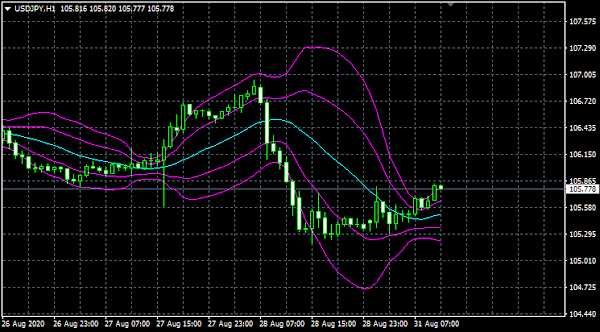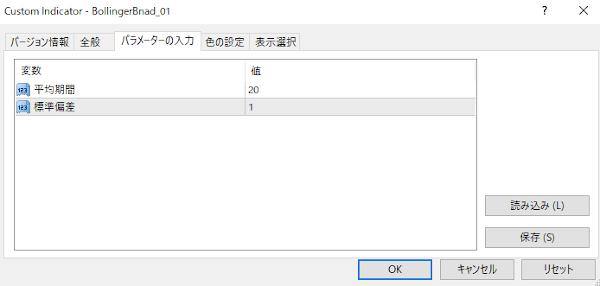トレンド系のインジケータとしてボリンジャーバンドは人気があります。このインジケータを作成してみましょう。
ボリンジャーバンド

ボリンジャーバンドはMQL4ではiBands()関数を使います。
|
1 2 3 4 5 6 7 8 9 10 |
double iBands( string symbol, // symbol int timeframe, // timeframe int period, // averaging period double deviation, // standard deviations int bands_shift, // bands shift int applied_price, // applied price int mode, // line index int shift // shift ); |
Ref: iBands – MQL4 Documentation
目次
1. サンプルコード
1. サンプルコード
サンプルコード
|
1 2 3 4 5 6 7 8 9 10 11 12 13 14 15 16 17 18 19 20 21 22 23 24 25 26 27 28 29 30 31 32 33 34 35 36 37 38 39 40 41 42 43 44 45 46 47 48 49 50 51 52 53 54 55 56 57 58 59 60 61 62 63 64 65 66 67 68 69 70 71 72 73 74 75 76 77 78 79 80 81 82 83 84 85 |
//+------------------------------------------------------------------+ // BollingerBand_01.mq4 //+------------------------------------------------------------------+ #property strict // インジケーターをチャートウィンドウに表示させる #property indicator_chart_window // インジケーター描画用のバッファー数 #property indicator_buffers 3 // 表示するインジケータのプロット数 #property indicator_plots 3 // 1番目のインジケータの描画スタイル #property indicator_type1 DRAW_LINE // 1番目のインジケータの描画色 #property indicator_color1 Aqua // 2番目 #property indicator_type2 DRAW_LINE #property indicator_color2 Magenta // 3番目 #property indicator_type3 DRAW_LINE #property indicator_color3 Magenta input int AvaregePeriod = 20; // 平均期間 input int Deviation = 1; // 標準偏差 // インジケータのバッファ double BufferMain[]; double BufferUpper[]; double BufferLower[]; //+------------------------------------------------------------------+ //| Custom indicator initialization function | //+------------------------------------------------------------------+ int OnInit(){ // Buffer配列を表示用として設定 SetIndexBuffer(0, BufferMain); SetIndexBuffer(1, BufferUpper); SetIndexBuffer(2, BufferLower); return(INIT_SUCCEEDED); } //+------------------------------------------------------------------+ //| Custom indicator iteration function | //+------------------------------------------------------------------+ int OnCalculate(const int rates_total, const int prev_calculated, const datetime &time[], const double &open[], const double &high[], const double &low[], const double &close[], const long &tick_volume[], const long &volume[], const int &spread[]) { // バーの数を取得 int limit = Bars - prev_calculated; for(int i = limit - 1; i >= 0; i--){ // Main BufferMain[i] = iBands( NULL, // 通貨ペア名, NULLは現在の通貨ペア 0, // 時間足, 0は現在の時間足、ENUM_TIMEFRAMES AvaregePeriod, // 平均する期間 Deviation, // 標準偏差 0, // バンドシフト PRICE_CLOSE, // サンプリングする価格, ENUM_APPLIED_PRICE MODE_MAIN, // インジケータライン i // 0が現在値で過去へのシフト ); // Upper BufferUpper[i] = iBands(NULL, 0, AvaregePeriod, Deviation, 0, PRICE_CLOSE, MODE_UPPER, i); // Lower BufferLower[i] = iBands(NULL, 0, AvaregePeriod, Deviation, 0, PRICE_CLOSE, MODE_LOWER, i); } return rates_total; } |
このサンプルではデフォルトで+/-1σのボリンジャーバンドを表示するためにiBands()をMainと+1σ,-1σの3つを記述しています。+/2σはパラメータで標準偏差を2にすることで可能です。(つまりMT4にあるものと同じ)
#property strict
を宣言することでコンパイラが厳しく警告を出してきますが、
|
1 |
input int Deviation = 1; // 標準偏差 |
のパラメータがコメントアウトした「標準偏差」と表示されます。

References:
Program Properties (#property) – MQL4 Documentation
iBands – MQL4 Documentation
ENUM_TIMEFRAMES – MQL4 Documentation
Price Constants – MQL4 Reference




































